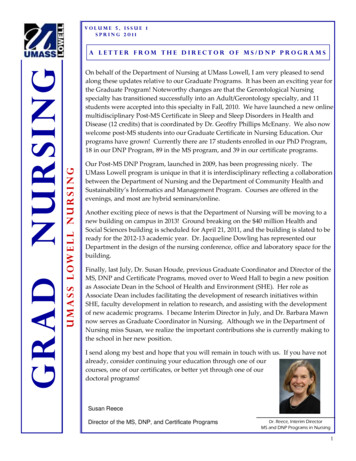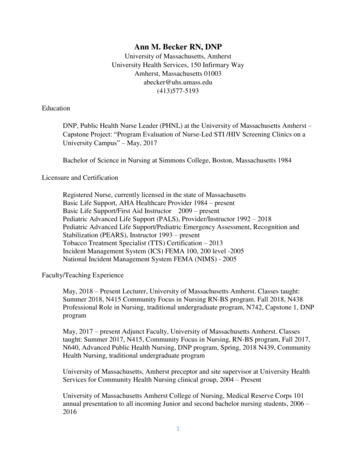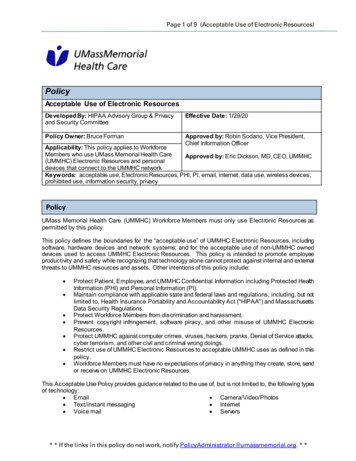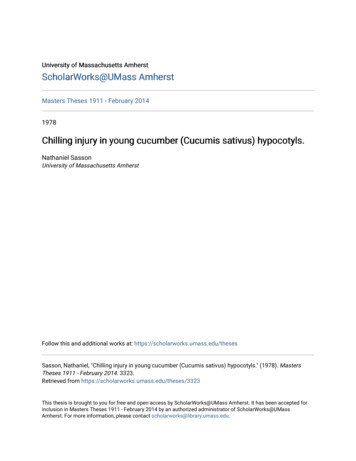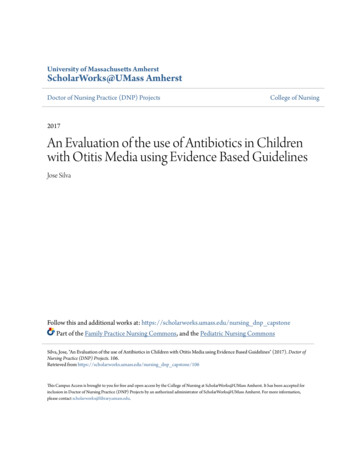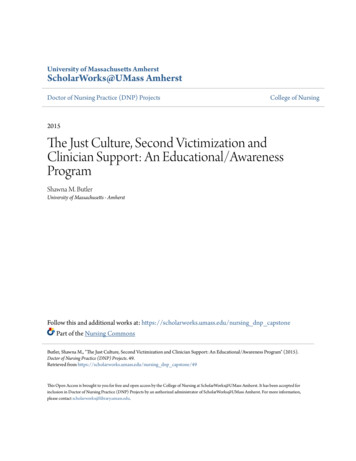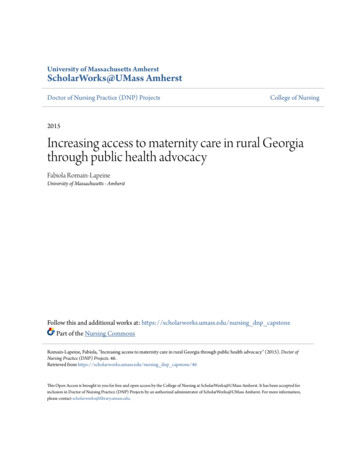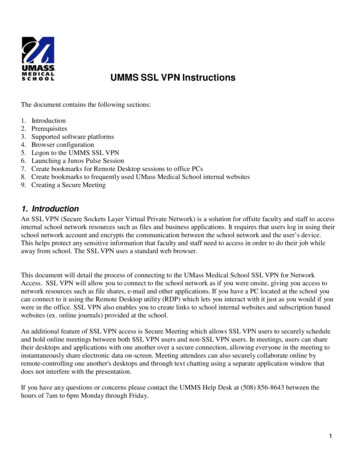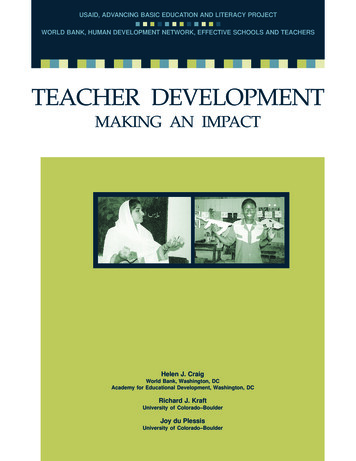
Transcription
USAID, ADVANCING BASIC EDUCATION AND LITERACY PROJECT WORLD BANK, HUMAN DEVELOPMENT NETWORK, EFFECTIVE SCHOOLS AND TEACHERSTEACHER DEVELOPMENTMAKING AN IMPACTHelen J. CraigWorld Bank, Washington, DCAcademy for Educational Development, Washington, DCRichard J. KraftUniversity of Colorado–BoulderJoy du PlessisUniversity of Colorado–Boulder
Teacher DevelopmentMaking an ImpactHelen J. Craig, Education SpecialistWorld Bank, Washington, DCAcademy for Educational Development, Washington, DCRichard J. Kraft, ProfessorUniversity of Colorado–BoulderJoy du Plessis, Research AssociateUniversity of Colorado–BoulderNovember 1998
Teacher Development: Making an Impactii
Teacher Development: Making an ImpactContentsDedication . vPreface . viiAcknowledgments . ixExecutive Summary . xi1. Teacher Development: A Process Along a Continuum of Learning . 1Introduction to the Study . 1Select Topics in Teacher Education . 3Conclusion . 192. Case Studies of Initial Teacher Preparation Programs . 21Botswana Primary Education Improvement Project (PEIP) . 21The Basic Education Teacher Diploma (BETD)—Namibia . 32The BRAC Experience—Bangladesh . 433. Lessons Learned About Initial Teacher Preparation Programs . 55Beginning Teacher to More Experienced Teacher—What Are theIssues Typically Faced? . 56Alternative Choices for Initial Teacher Preparation . 56Elements of Successful Traditional Formal Teacher PreparationPrograms . 60The Move to General Education Programs . 63Recruitment and Retention of an Adequate Teacher Supply . 64Teacher Educators . 68Induction Programs . 69Classroom Supervision of Teachers . 72Accreditation Standards for Teacher Education . 73Conclusion . 744. Case Studies of Ongoing Professional Development Programs . 77Guatemala: Changing Teacher Pedagogy in the Nueva EscuelaUnitaria . 77Balochistan, Pakistan: Gender Equity, Mobile Teacher Training,and Mentoring . 915. Lessons Learned About Ongoing Professional DevelopmentPrograms . 105Definition of Terms . 105What Works, What Does Not, and Why? . 105Characteristics of Effective Programs . 106Organizational Models . 112Evaluation of Inservice Programs . 118Teacher Evaluation as Part of Professional Development . 119Snapshots of Eight Inservice/Professional DevelopmentPrograms . 123Conclusion . 1406. Conclusions and Recommendations . 141System Support . 141Ongoing Professional Development—The Early Years . 142Ongoing Professional Development—The Years After InitialPreparation . 143iii
Teacher Development: Making an ImpactAnnex 1: A Framework of Relationships and Priorities among CriticalIssues Affecting Teachers’ Work—Morale and Motivation. . 145Annex 2: More and Less Effective Teacher Education Strategies inDeveloping Countries . 147References . 153iv
Teacher Development: Making an ImpactDedicationWe dedicate this work to the thousands of classroom teachers, whodespite low pay, overcrowded classrooms, often nonexistent initialteacher training, inadequate inservice development, lack of desks andchairs, few or nonexistent textbooks or other instructional materials, nolibrary, poor sanitary facilities, and little or no transportation to theirschools, somehow make it to school almost every day and attempt toteach their children. Our second dedication is to the millions of children,who go to school with the often vain hope that it will lead to a better life.One of the coauthors observed forty second graders in a West Africannation “wait for teacher” for over four hours in searing heat, arriving ontime, causing no discipline problems, but just patiently waiting for anadult to “teach” them. This level of dedication is seldom seen in thewealthier nations of the world, and we applaud it, but despair at theconditions that leave millions of children untaught each day of the year.In the midst of these discouraging circumstances, however, weobserved reflective teaching at its best: classrooms of a democraticvariety to make John Dewey proud, communities and parents moreempowered than those in many wealthy nations, creative problemsolving, and active learning utilizing the best of local culture andmaterials under the most difficult of circumstances.While sound education exists in most industrialized nations with theirtremendous resources, the fact that some of the most creative, reflective,and active-learning classrooms were observed in some of the mostrural, poor, and multigrade settings in the world made it clear to us thatwhen teachers are empowered, almost anything is possible. Manyteachers, children, and communities of the world are ready, butregrettably, we cannot yet say the same for the governments andinternational agencies, who will be asked to fund or “bring to scale”these programs.Outdated initial training programs; short, disconnected inservicetraining; inadequate textbooks; blackboard-based pedagogy; overlyused norm-referenced summative evaluations; and a host of otherchallenges characterize too many millions of classrooms today. A fewcountries have permitted a few pilot programs to risk breaking thiscycle. We have been privileged to catch a glimpse of some of theseexceptional classrooms that function in a cost-effective, sustainablemanner. Our only hope is that this manuscript can, in some small way,help to promote the exceptional programs and lessons learned fromthese experiences that these caring teachers, children, and communitieshave brought into existence.v
Teacher Development: Making an Impactvi
Teacher Development: Making an ImpactPrefaceThe ABEL2 Project (Advancing Basic Education and Literacy)—aninitiative of the United States Agency for International Developmentunder the auspices of the Academy for Educational Development—andthe World Bank both sought an updating of promising practices inteacher education. ABEL2 also particularly requested that we addressthe question of whether teacher education affects children’s learning.While this work was never intended to be a formal impact study, weundertook the case studies to look very carefully at this question. Ratherthan duplicate efforts, we decided to combine the ABEL2 and WorldBank studies, making use of the extensive archives of USAID, the WorldBank, and other multilateral and bilateral educational assistanceprojects. We specifically sought out programs that both internal andexternal evaluators considered “successful,” and that evidenced bothcost effectiveness and sustainability.It became very clear that it is difficult to discuss teacher education andlearning outcomes without referring to other aspects of teacherdevelopment, including incentives; management of teachers and thelarger system; recruitment, deployment, and retention of teachers;evaluation; and the place of teachers in educational reform. We refer toaspects of these larger issues, but their greater exploration was beyondthe scope of this study. We strongly encourage additional research anddocumentation of these processes, which will strengthen strategies toimprove the quality of teachers’ and children’s learning.After reading many reports, evaluations, and research studies, wevisited some ongoing projects that appeared to have promising teachereducation components and about which more extensive case studiescould be written. The reader will find case studies on projects inBalochistan, Botswana, Guatemala, Bangladesh, and Namibia, as wellas references to projects in various other countries. The case studies arein no way meant to cover all the aspects of these complex and oftenlengthy projects, but rather to highlight certain teacher educationcomponents that we and other external researchers have found to beparticularly compelling. Nor do we mean to say that these projects arenecessarily better than the many others. We do believe, however, thatthere are important aspects of each of them that can inform nationalpolicymakers and international donors and lenders in the coming years.It is presumptuous to attempt to cover all aspects of teaching andteacher education worldwide in one review, and we continuouslyfound ourselves having to limit our work, due to time, travelconstraints, and the multiple scenarios of teacher development atdifferent stages of the learning process in countries at different stages ofeconomic development. We do, however, attempt to provide evidencevii
Teacher Development: Making an Impactthat teacher education programs do enhance student learning;summarize research on effective teaching and schools; summarizeguidelines to assist with the development of more effective teachereducation programs; and describe ongoing teacher developmentprograms from different parts of the world.We end our report with recommendations. They are based not only onour own research, experience, and site visits, but on the work of manydedicated teachers, teacher educators, program administrators,ministry of education officials, international consultants, researchers,and evaluators. We trust that we have done them justice in our attemptsto synthesize their work.viii
Teacher Development: Making an ImpactAcknowledgmentsTeacher Development: Making an Impact has been produced as a jointventure between the World Bank and Project ABEL 2 (Advancing BasicEducation and Literacy), an initiative of the United States Agency forInternational Development under the auspices of the Academy forEducational Development. The content and design owes a great deal tothe encouragement of colleagues at the Academy for EducationalDevelopment, USAID, the World Bank, and other education agencies.We would like to gratefully acknowledge the help of each of thesepeople and those in the field who willingly gave their time, information,and counsel so we could better understand various dimensions ofteacher development programs.Individuals who provided valuable written comments and insights onthe document include David Chapman (University of Minnesota),Francy Hays (AED), Jim Hoxeng (USAID), Kathryn Johnson (WorldBank), Gary Knamiller (University of Leeds, UK), Eileen Nkwanga(World Bank), Maria Teresa Tatto (Michigan State University)Bernadette Robinson (formerly from the Open University, UK), andEluned Roberts-Schweitzer (World Bank). Sena Hubler (World Bank),Rose Thomas, Peggy Kong, and Leslie Enright (AED) assisted withcopyediting and bibliographic details. The report was prepared forpublication and edited by John Engels (AED).Finally, we would like to offer special thanks to the many governmentalofficials, teachers, teacher educators, and international consultants whofacilitated our site visits to their projects and made us feel so at home.They not only provided us much documentation on their projects, butalso openly shared their successes and failures with us, and extendedsuch overwhelming hospitality. Our special thanks to all of you.The contributions of all the above colleagues are greatly appreciated, forthey have helped us refine our understanding about how to improve thequality of teachers and teaching.ix
Teacher Development: Making an Impactx
Teacher Development: Making an ImpactExecutiveSummaryThis study began as an update of promising practices in teachereducation programs that have been particularly successful inenhancing student learning in their own context. Along the way ofundertaking case studies in Bangladesh, Botswana, Guatemala,Namibia, and Pakistan, and collecting other research on promisingpractices, we expanded the study to include several related topics,including the impact of teacher education on children’s learning;effective teaching; trends in teacher development from around theworld; recruitment and retention of teachers; incentives; andevaluation, supervision, and management, including cost-relatedissues.The intervention and program ideas suggested in this report areintended to provide the project manager or planning official with arange of alternatives and guiding questions to discuss with various incountry stakeholders. Questions of what is feasible in the short andmid-term, and what plans should be worked towards over the next tento fifteen years for longer-term plans need to be part of this discussion.Some of the suggested ideas are drawn from the case studies. We do notsuggest that these programs are ideal in every way, but they do providepractical guidelines to shape good practice elsewhere. Other suggestedideas come from additional research literature. The following are selectkey findings and recommendations.Teacher Education Can Make a Difference to StudentAchievementTeacher education programs can make a difference to studentachievement depending on the type of education program and supportthat is put in place. Specific factors such as the years of teacher training(initial and inservice), the teacher’s verbal fluency, subject matterknowledge, having books and materials and knowing how to use them,teacher expectation of pupil performance, time spent on classroompreparation, and frequent monitoring of student progress are all keyfactors identified in some key research studies that have a positivebearing on the quality of teachers’ performance and, consequently,student achievement. Many of these factors were confirmed by the casestudies.Julie Owen-ReaTeachers Need to Be Actively Involved in the ChangeProcessWhen teachers are actively involved and empowered in the reform oftheir own schools, curriculum, pedagogy, and classrooms, even thosewith minimal levels of formal education and training are capable ofdramatically changing their teaching behavior, the classroomenvironment, and improving the achievement of their students.xi
Teacher Development: Making an ImpactConversely, when teachers are ignored, or when reforms come fromabove or are not connected to the daily realities of the classroom andlocal environment, even the most expensive and well designedinterventions are almost guaranteed to fail. Our review of the literatureand case studies confirm that when teachers are involved in makingdecisions about changes that affect them, enjoy being around children,have the skills to impart appropriate knowledge and manage theirclassrooms, and understand their role in the broader community, theyusually are highly motivated and their students’ achievement tends torise.Teacher Development Is About Ongoing ProfessionalGrowth and SupportFrom the time teachers begin any initial preparation or teaching,provision needs to be made for ongoing development of their subjectmatter knowledge; concrete skills to teach, observe, assess, and reflect;incentives; and career growth. There also needs to be linkages withother teachers and supervisors to help them solve problems andsupport each other through discussion, modeling and coaching, andinvolvement with other aspects of school and educational change.Isolation and lack of communication between all players needs to bereduced. Ministries of education and regional office staff have aresponsibility to provide sufficient teaching and learning materials tosupport the curriculum, adequate facilities, and ongoing support for theissues that teachers face.Teacher Development Is a Process Along a Continuum ofLearningTeacher development is a process, not an event. It involves change overtime and is achieved in stages. The stages are related to teachers’experience gained in instructional and management practice over theircareer. The stages are also related to the degree of services and supporta country’s level of economic and political development allows it toprovide.Linda BrownStrategies must begin at the teacher level and be aimed at helping eachteacher facilitate change in the classroom. Just as the success of eachschool is the key to overall quality improvement in the educationsystem, the success of teacher development within the school must beaimed at the success of each teacher to help children learn.xiiAlternative Teacher Education Programs Should BeConsideredThere are a variety of ways to prepare and support teachers in a varietyof environments. Initial preparation of teachers varies greatly across
Helen CraigTeacher Development: Making an Impactcountries. Where they exist, programs have worked well when theyhave ranged from fifteen days as in the BRAC schools in Bangladesh,twenty-five days in the rural community schools in Egypt, two-yearprograms in Botswana, three years in Namibia, to the five-yearprograms as found in some U.S. institutions. Success depends on howthe courses are structured and what support accompanies them.Practical training, based on the realities of the classroom and ongoingon-the-job support, is the critical factor in any successful teachereducation program. Teachers who have shorter initial programs tend torequire more concentrated follow-up while on the job. Where there is anissue with getting females trained in restricted social regions, mobileteacher training has proved helpful. Distance education, when carefullydesigned for large numbers of students, appears to be significantly lessexpensive than traditional residential programs in producing“certified” teachers. Alternative programs such as shorter school-basedprograms with ongoing mentoring and support should be considered,particularly in education systems with shortages of trained teachers.It Is Important to Create Conditions that Lead toSustainabilitySustainability of a teacher development program is strengthened wherethere is long-term involvement by stakeholders, sufficient institutionalcapacity, appropriate incentives and rewards, political stability andcommitment, and effective phasing out of outside donor resources.RecommendationsFundamental changes in the following three areas are required if thequality of teachers and teaching is to be significantly improved. Somekey recommendations identified from the study are:1. System Support Establish commitment in the form of vision, policies, plans, andactions for long-term professional development of teachers. Somecrisis management may be needed in the short term.Delegate to the school the authority, flexibility, and responsibility todevelop relevant programs and school schedules to establish thislong-term professional development commitment.Define the rights and responsibilities of the various administrativegroups within the education system to clarify issues of neededlegislation, infrastructure, functions, and communication.Require school supervisors to inform teachers and head teachers ofpromising teaching practices, and assist staff in trying these out.Assist schools to provide necessary teaching resources to achieveinstructional goals.xiii
Teacher Development: Making an ImpactAllow freedom of professional association and some form ofcollective bargaining consistent with labor legislation; involverepresentatives of these associations in reform discussions, andestablish arbitration procedures. Develop human resource development strategies that are long-termand ongoing, depend heavily on school-based inservice programs,and link training and upgrading to a career-path structure. Hire committed teachers and provide adequate training and support to enable them to do their job. It is preferable to hire teacherswith at least nine years of general education (the number is not key,just the need for more general education) and with some teachingtraining. Provide a range of incentives for different stages of teachers’careers to attract suitable candidates to teaching, establish jobsatisfaction, and improve instructional practice. Incentives can bedirect monetary benefits (e.g., teacher salary, allowances, and fringebenefits), indirect monetary benefits (e.g, professional training,teacher guides, textbooks, instructional supervision, subsidizedhousing, food, and transportation), or nonmonetary benefits (e.g,professional status in the community, location of teaching position,and recognition of performance). They must match the needs ofteachers if they are to be true incentives. Thus, different incentivesare important at different stages of a teacher’s career. 2. Ongoing Professional Development—The Early YearsProvide focused instruction for new teachers. Beginning teachersneed initial preparation in their subject matter, fluency in thelanguage of instruction, knowledge of how to use instructionalmaterials, and some basic classroom management and reflectionskills. Most of these skills are best learned through on-the-jobpractice with coaching, which can be done through a traditionalpreservice program with substantial supervised practice teaching,or with close supervision and ongoing inservice training while onthe job. Consider a range of alternative teacher preparation programssuitable to or adapted to local needs and constraints. Programssuch as shorter school-based initiatives with ongoing mentoringand support should be considered, particularly in education systems with a great shortage of trained teachers. Establish an appropriate system of standards accreditation tomatch the preparation program so that all teachers can worktowards both high standards and the same professional status. Require teacher education faculty to be active in classroom andschool research, model good practices in their own teaching,Linda Brown xiv
Teacher Development: Making an Impactimpart clear subject pedagogies, have a clear concept of how adultsand children learn, and take time to reflect with students aboutteaching practice. Establish induction programs. These are essential to guide andsupport beginning teachers in their first few years of teaching, helpdevelop sound teaching practices, and retain teachers.3. Ongoing Professional Development—The Years After InitialPreparationBroaden the concept of inservice programs and support to mean agrowth continuum of ongoing, participatory learning that is closely tiedto the realities of classroom needs. Focus inservice programs on specific training for subject knowledge, pedagogy, and classroom management that is appropriate tothe teacher’s current needs. Ongoing guidance and support, thesharing of ideas and concerns among teachers, the support of thehead teacher, and obtaining sufficient release time to participate intraining are some of the key elements these programs should focuson. Extend the evaluation of teacher education programs beyondinforming facilitators and administrators of the modes of presentation, relevance, adequacy of facilities and instructors, etc. Theevaluation must also investigate whether attitudes and practices ofparticipants have actually changed for the better and whether thesechanges are manifest in classroom and school practices. Aim classroom supervision by inspectorate supervisors, headteachers, and peers at improving teacher performance in the classroom. An effective teacher is able to discern from among alternatives what enhances student learning and what does not, andworks to that end of raising student achievement. Teacher performance evaluations should help teachers make a better learningenvironment for students.Anne Sweetser xv
Teacher Development: Making an Impact1. TeacherDevelopment: AProcess Along aContinuum ofLearningWhen teachers are involved in appropriate decision-making processes, are ableto reflect on and change their circumstances, enjoy being around children, havethe skills needed to impart appropriate knowledge and manage theirclassrooms, and understand their role in the broader community, they areusually highly motivated and student achievement tends to rise. Theseelements are usually developed over time and with practice.Many years ago, one of the coauthors of this manuscript asked a largegroup of primary and secondary school principals what was the mostimportant factor contributing to an effective school. The principals citedstudent-centered learning, a democratic learning environment,outstanding leadership, high standards and expectations and a range ofother factors. The principal of perhaps the most student-centered,democratic school in the country shocked everyone when he said thathe built his school around his teachers. When teachers were motivated,committed, and happy to be there, the rest of the work would fall intoplace. Our review of the literature and our site visits confirm that whenteachers are involved in decision-making that affects them, are able toreflect on and change their circumstances, enjoy being around thechildren, have the skills needed to impart the knowledge for which theyare responsible, and understand their role in the broader community,they are usually highly motivated and student achievement tends torise. While this is true of far too few schools and classrooms around theworld, we observed and read about some exceptional places whereteachers love to teach and were developing confidence and new skills,and where children really learn. This is happening in some of the mostunlikely places: poor, rural, bilingual, and multigrade settings, withunderpaid teachers possessing limited instructional materials andtraining.Introduction to the StudyTeresa KavanaughWe want to make the case that even small changes with teachers andtheir learning environments—changes of the right type, that is—canmake a difference to children’s learning and retention in the educationalsystem. Helping teachers to be knowledgable and responsible enoughto make needed adjustments to the learning environment is one of thesechanges of the “right type.”In considering raising the quality of teaching, one must begin at theteacher level. Teacher development must be seen as a continuum oflearning, with teachers located at various places along the continuum.(The stage of a country’s development will also affect the range oflearning experiences on this continuum.) Teaching experience is gainedover time. Long-term goals for excellence in teaching should be1
Teacher Development: Making an Impactambitious, but short and mid-term goals must reflect the reality of theeveryday working situation for teachers. Even if only very modestchanges are produced, such as getting a teacher to come to class eachday and undertake basic skills training with rote methods, thisrepresents progress if before the teacher did not even make it to class.While there are certainly better methods than rote to help childrenlearn, the point is that planners and administrators may need to havemodest goals in the initial stages of enacting a teacher developmentprogram. However, they should never lose sight of moving forward tothe goal of creating a teacher who will use a variety of interesting andeffective learning methods. The case studies highlight the importanceof schools and regions having an ongoing long-term professionaldevelopment program that helps create this kind of teacher.In this study we provide guidelines for improving the professionaldevelopment of teachers. These guidelines provide a range ofalternatives that have been tried in systems that have very constrainedresources as well as in those that are well established. Several requestsfrom colleagues were made to develop a conceptual framework thatsets out different teacher development strategies for the varying stagesof a country’s development. This was not possible for the study, but wehope to articulate this better in a forthcoming work.Some of the suggestions are drawn from the case studies—key factorsthat have been particularly successful in enhancing student learning inteacher education programs. We do not suggest that these programs areideal in every way, but they do provide practical guidelines to shapegood practice elsewhere. Other suggested ideas come from additionalresearch literature. The case studies
Teacher education programs can make a difference to student achievement depending on the type of education program and support that is put in place. Specific factors such as the years of teacher training (initial and inservice), the teacher’s verbal fluency, subject matter knowledge, having

